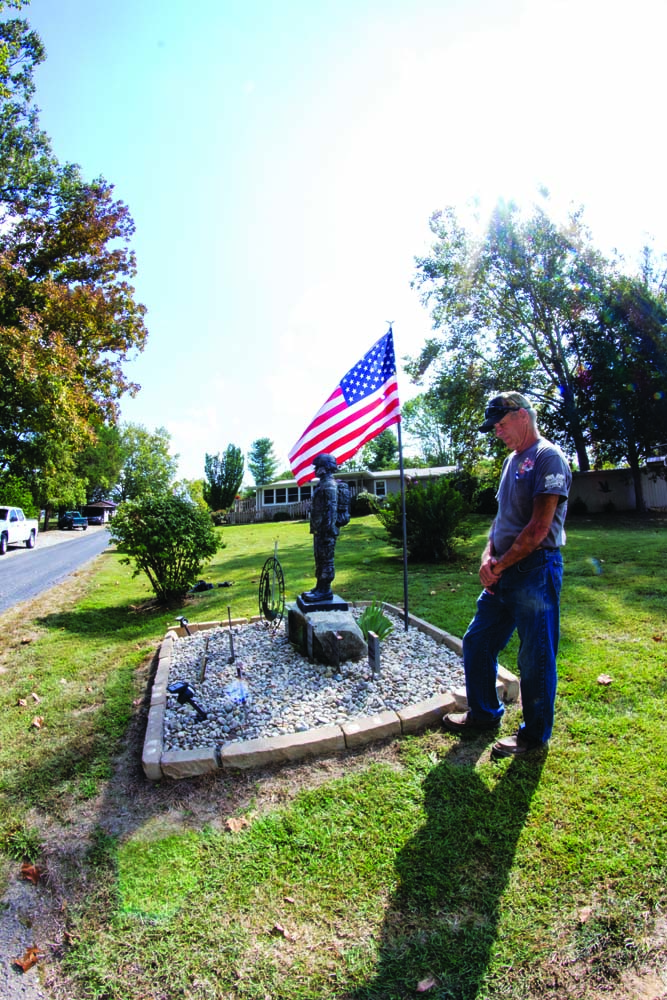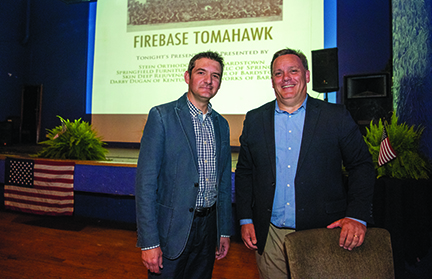Bardstown’s Band of Brothers
Loss and healing 50 years after Vietnam
June 19, 1969.
Not a day goes by without somebody in Bardstown thinking about that day.
People like Don Parrish and Ronnie Hibbs, who were at Firebase Tomahawk when it came under attack in Vietnam.
“Time moves on but lives were lost and changed, and it shouldn’t be in vain,” Parrish says.
Betty Stone thinks about that day, too. Her husband, Charles “Skippy” Stone, was with them in Vietnam.
Betty is now the “cornerstone” for information on Battery C. Their families still get together, most recently to watch a new documentary on the events that unfolded on Tomahawk, half a world away.
Fifty years later, reckoning day happens in fleeting moments each day for many of them.
This battle didn’t change the course of the Vietnam War, but changed the course of countless lives in Bardstown, the home base of the 138th Field Artillery Unit, Battery C, Kentucky National Guard.
Just over 100 men in Battery C were ordered to active duty the year before, in the spring of 1968.
Parrish was 26 years old and chief of the unit’s Fire Direction Center. His father heard Battery C had been called up on WHAS-AM radio.
Parrish drove straight to the armory to get more information: “I was surprised; not many National Guard units were being called to active duty in Vietnam.”
Parrish thought they might be headed to nearby Cincinnati for riot duty with so many protests breaking out, but quickly learned the final destination was Vietnam, providing cover for the 101st Airborne Division out of Fort Campbell.
Hibbs, who was a gunner for Battery C, was painting a car in his garage when he heard the news on the radio.
Even as they trained in Texas in the coming months, Hibbs says, “There was still a little bit of disbelief.”
Betty Stone had just given birth to her first child, a son, when she got the news her husband was being called up. “We had no idea what we were in for,” she says.
Skippy Stone would be headed to Vietnam along with his brother, Stanley.
There was unease about the war, but there was camaraderie within the unit, and Bardstown supported its band of brothers. It was a band of brothers in the truest sense, with seven pairs of brothers called up.
In a town of about 5,000, you were either family or you grew up together. It’s why those events on June 19, 1969, would prove so devastating for the close-knit town.
As the attack was unfolding, the men of Battery C already understood this. Parrish says fellow guardsman Jodie Haydon uttered the words, “This is going to kill the people of Bardstown.”
The battle unfolds
It was a rainy night on Firebase Tomahawk when the North Vietnamese Army, or NVA, launched its surprise attack. Heavy rains helped to drown out the sounds of their movement; many of them were nearly nude so clothing wouldn’t get caught on wire as they infiltrated the lower spot between two bigger hills.
The attack began at 1:45 a.m., with about half of Battery C asleep, the other half on duty.
David Collins was the first to be killed encountering the enemy, sounding the alarm that all hell was about to break loose.
The enemy was armed with satchel charges, tossing those packages of TNT. The only light would be from those explosions.
“It was utter chaos,” Parrish says. “It was completely dark, like the inside of a cow, no moon or stars.”
Parrish was with Tom Raisor, who began calling the 101st for help, but for a while, the men of Battery C were on their own with an enemy they couldn’t see. They fired rifles, machine guns—whatever they could—to try to regain control.
Parrish was in the only bunker that wasn’t destroyed.
One of his friends, Jim Moore, came inside, and as Parrish put his hand on his shoulder, he realized when it slid off that Moore was badly burned and was standing because it hurt too much to lie down.
Hibbs had the night shift and was with three others in his gun, resembling a mini-tank, when the attack began.
“I remember opening the back door to get out, something thrown would catch my shirt on fire. I remember turning two flips from the explosion, and I landed still running toward the bunker,” he says.
Hibbs didn’t think he would make it out. Two Army soldiers with him would not. He would be flown off Tomahawk to be treated for his injuries, and not return until years later.
Gunships with spotlights from the 101st would begin taking their toll on the enemy. By 5 a.m. the attack was over, daylight revealing the devastation and the human toll.
Nine artillerymen were killed, five from Battery C:
David Collins, who encountered the enemy first. Ronnie Simpson. Ronnie McIlvoy. Luther Chappell. Jim Moore, the man who entered the bunker so badly burned, would die five days later.
Bardstown would bury its sons, overflow crowds spilling out of churches with each service. Stone, whose husband made it home, says it was an outpouring of sympathy and respect.
A return—and another trip
Parrish says the healing continues, and it was part of that healing that would bring me into Battery C’s inner circle.
As a reporter with WHAS-TV, I traveled back to Vietnam with seven members of Battery C in 1995 to revisit the site of Firebase Tomahawk.
My dad had served two tours in Vietnam, and I, too, felt there was unfinished business with a war that took its toll on my family, and countless others I knew.
Parrish and Hibbs were among the seven returning. They weren’t sure what to expect, but felt a calling to go.
Hibbs, who erected a memorial in his backyard to his fallen brothers, returned to Tomahawk to say goodbye, something he wasn’t able to do after being injured and flown out.

“Some thought we were crazy to go back, that the war was still going on, but we were welcomed back,” Hibbs says.
That warm embrace from everyone in Vietnam may have been the biggest surprise, says Parrish. Their healing was underway, too, just as it was for the American vets.
The men of Battery C, using maps dating back to the war, found where Tomahawk used to be, and held a service for their fallen comrades, laying a wreath where so much loss occurred. Each one knew it could have been him.
I witnessed some of that grief, and perhaps even some survivor’s guilt, lessening just a bit. They found some solace, and in turn so did I, in part for my father, and for families I knew who lost their dads.
And now, 50 years since the attack, there was to be one more trip for this band of brothers—to Washington, D.C., on an Honor Flight.
This time, more than 40 members of Battery C signed up to go. I was invited to speak at a news conference kicking off the fundraising efforts, back with many of the men who revisited Vietnam with the WHAS-TV news crew.
More than $35,000 was raised to help fund the Honor Flight, evidence that Bardstown still remembers.
“It will be an emotional trip no one will ever forget,” Parrish said before their scheduled departure in mid-October, after this issue of Kentucky Living had gone to press.
With more than 30 men in the unit passing away through the years, Hibbs adds, “This could be our last hurrah.”
Betty Stone’s husband, Skippy, was to make the trip, his first time to the Vietnam Memorial, and she knows it will be hard.
Life after war, she says, hasn’t been easy: “I am hoping he can find some peace.”
Hibbs walks 2 miles every morning, and in that quiet time, he reviews the names of the friends he lost, his daily remembrance.
As long as members of Battery C are alive, Parrish says it’s their duty to remember those names and what happened on June 19, 1969.
Brothers forever, in life and in death.
Hometown filmmaking for hometown heroes

An independent Bloomfield production company has released its latest documentary, Firebase Tomahawk, on DVD, telling the story of Battery C. A screening for the film with dinner is planned for Friday, November 22, 7:30 p.m., at Kresos in Bardstown. Tickets ($10) will be sold at the door if the showing does not sell out in advance. Call (502) 507-2798 to purchase advance tickets.
Tunnell Mill Pictures (TMP) produces documentary and narrative feature films. Call the number above or visit www.tunnellmillpictures.com, to purchase the DVD Firebase Tomahawk for $20, plus shipping.

